Homemade chicken stock/broth slowly cooked with ginger, green onion, and garlic. The stock with gingery fragrance gives nice flavors to many Asian dishes and soups you make at home!
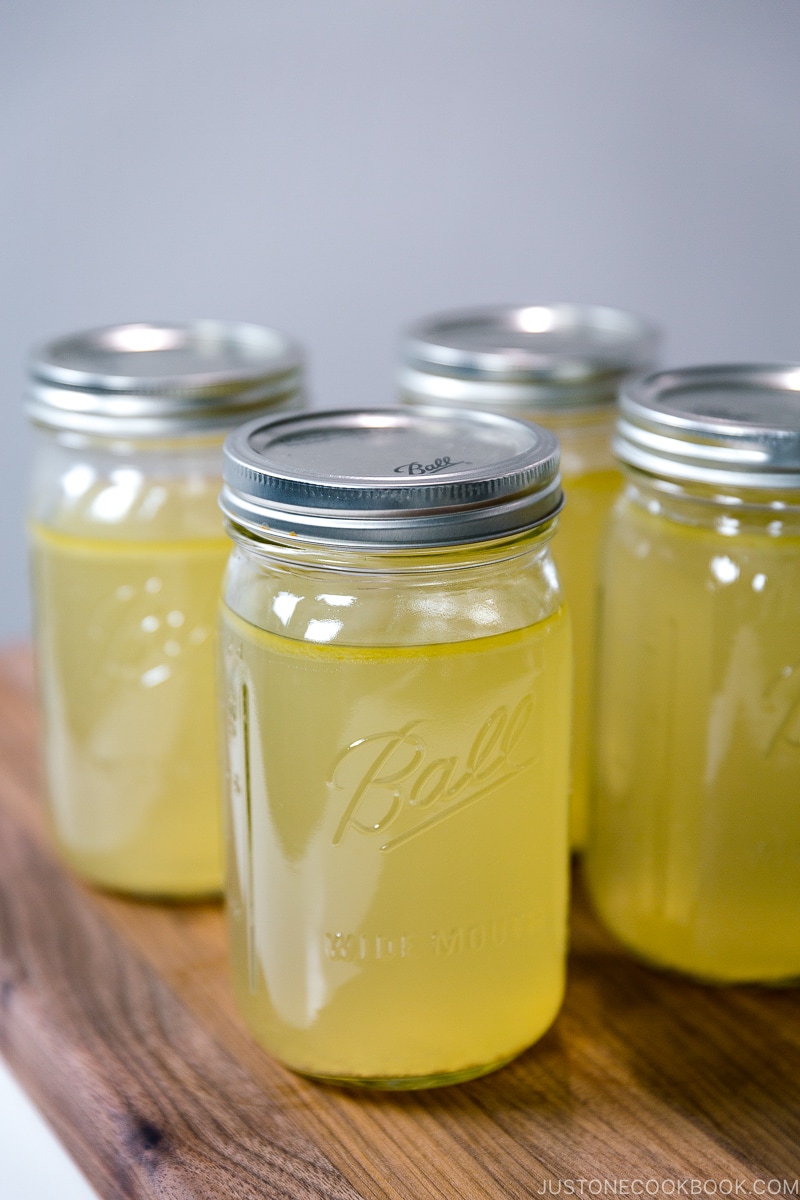
In Asian cooking, we use chicken stock to make soups, noodle soups, hot pots, sauces, and many other dishes. It’s important to note the flavor profile of Asian chicken stock is very different from western one and they shouldn’t be used as a substitute.
Asian Chicken Stock vs. Western Chicken Stock
How is the chicken stock used in Asian cooking different from western chicken stock? While western chicken stock includes celery, carrot, parsley, and other herbs, Asian chicken stock is rather simple. We only use chicken bones, ginger, green onion, and garlic (optional).
Western chicken broth has stronger flavor components with all the additional vegetables, and it tastes really delicious for soups and stews. However, the flavor profile doesn’t work for wonton soup, ramen, hot pot, and so on.
Store Bought or Homemade Chicken Stock
We don’t always have homemade chicken stock ready for use in the refrigerator or freezer, and sometimes there is no time to make chicken stock from scratch.
On those occasions, I use a can of Asian chicken stock. You can find these at many Asian grocery stores.
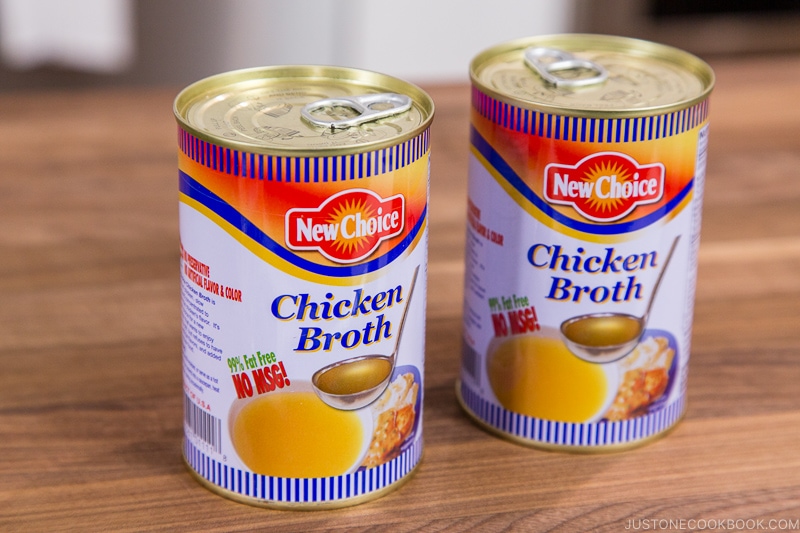
The store-bought chicken stock can be too salty, so make sure to dilute with water in a ratio of 2 parts broth to 1 part water (4 cups broth: 2 cups water) as a good starting point. You can always adjust the flavor to your liking by tasting the broth.
Homemade Chicken Stock
There are probably several (if not many) ways to make chicken broth, as each family has their own version. This is how I make my chicken stock.

Fun Fact: It’s actually not common to make chicken stock from scratch in Japan because it’s not easy to find chicken bones or whole chicken at local Japanese grocery stores. Therefore the Japanese use the Chuka Dashi Powder (中華だし) to make Asian (especially Chinese) cooking.
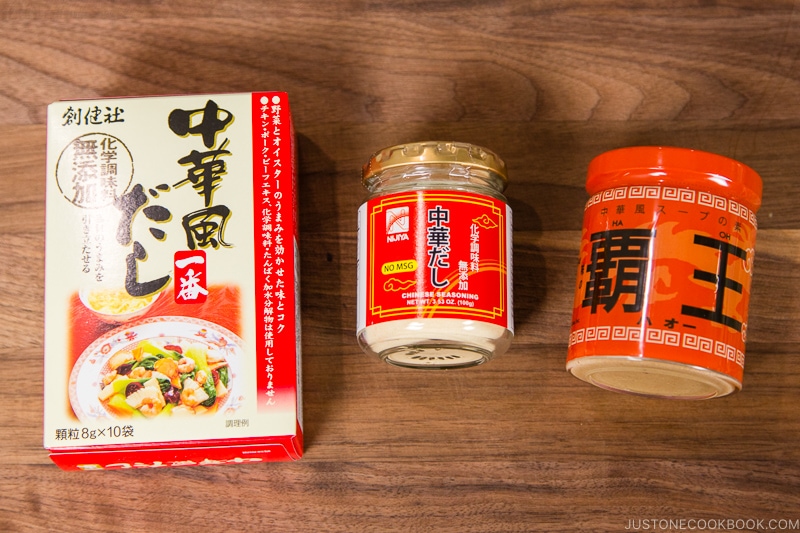
If you want to learn more about Chuka Dashi, please read this post.
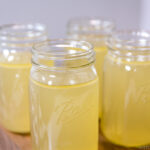
Homemade Chicken Stock
Ingredients
- 4 lb chicken backs and necks (8 pieces)
- water (for prepping the chicken bones)
- 2 inches ginger
- 3 green onions/scallions
- 1 clove garlic
- 4½ QT water (17 cups)
Instructions
- Gather all the ingredients. If you‘re using frozen chicken, make sure that it‘s completely defrosted.
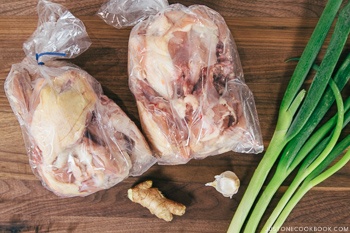
- Rinse 4 lb chicken backs and necks quickly and soak in cold water for 30 minutes. Replace the water several times. This helps to remove blood.
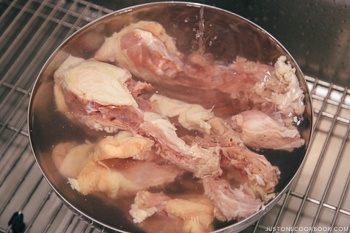
- Slice 2 inches ginger (keep the skin on), cut 3 green onions/scallions in half lengthwise, and smash 1 clove garlic. Tip: As you can see in the images, this time I used 2 Tokyo negi (Japanese long green onion) and 2 green onions. I think the green part was too much. While the stock tastes fine, it lacks a golden color. I‘d recommend sticking with the recipe calling for 3 green onions.

- In a stock pot, bring water to boil. Add the chicken and cook for just 20 seconds. Immediately drain.

- Under cold running water, clean the chicken bones very well. Use your thumbs to go in and remove any blood or offal that might be attached.

- Chop the bones into 2-inch (5-cm) pieces. This helps the flavors come out better from bones.

- Place the clean chicken and 4½ QT water (4 L, 17 cups) in a stockpot. Bring to boil over high heat. Prepare a fine mesh skimmer and water in a 2-cup measuring cup for cleaning the skimmer (this a helpful trick).
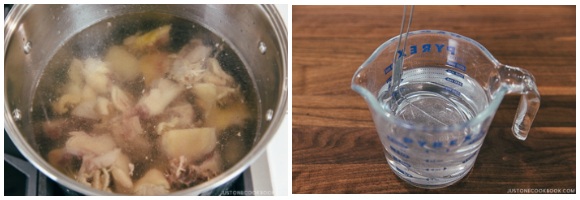
- Once boiling, immediately reduce heat to bring the stock to barely a simmer. If you boil on high heat, the stock will be cloudy. Next 15 minutes or so, skim the scum and foam on the surface with a fine mesh skimmer. It‘s tedious work but it helps make better stock.

- Once the stock is clean and there‘s nothing left to skim, you can now add ginger, green onion, and garlic.
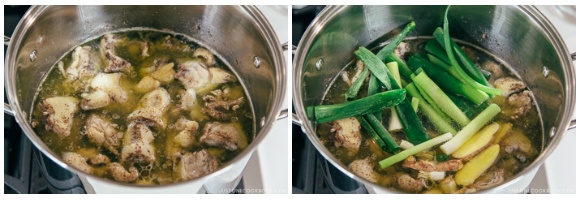
- Continue to cook for 3–6 hours (or you can pressure cook for 40–45 minutes). This time, I was running out of time, so I cooked for 2½ hours but it still tasted amazing.
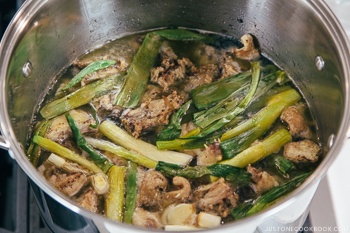
- Pick up the bones and other solids with a skimmer or slotted spoon. Then, pour the chicken stock into a fine-mesh sieve over a large bowl.
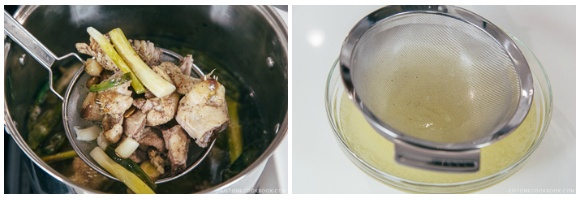
- The chicken stock is ready to use. Season with kosher salt as you like. For later use, divide the stock into mason jars and allow to cool uncovered. Keep the oil on top and once the oil is solidified, you can decide to use it for cooking or discard it.

To Store
- The stock will last up to a week in the refrigerator or in the freezer for several months. Just be sure to leave enough headspace (2 inches, 5 cm) for the stock to expand.
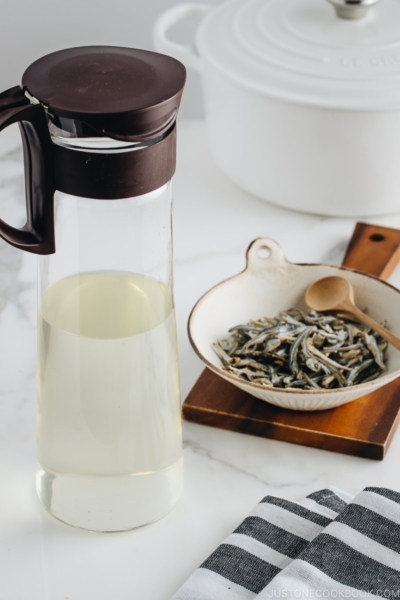

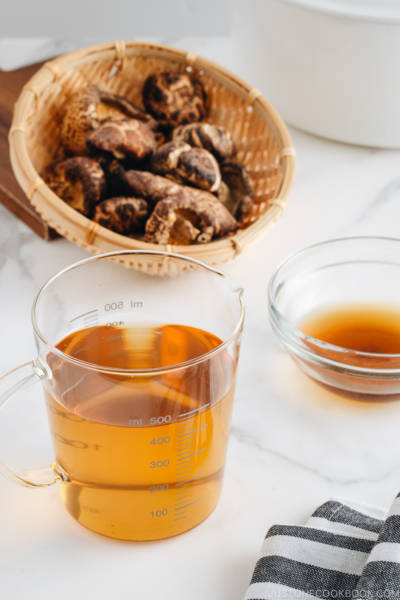
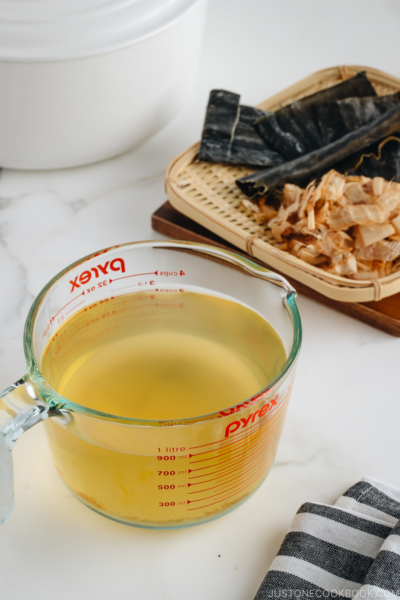




Hi. Would you please let me know where can i find the red weipa that you have in the picture in US/Canada? Thanks alot.
Hi Vienna! Thank you for reading Nami’s post and trying her recipe!
We usually find this Weipa seasoning at the local Asian grocery stores. But you can also purchase it from the Amazon store. https://www.amazon.com/dp/B08BL2Z96H?ref=exp_justonecookbook_dp_vv_d
And here is a list of Japanese grocery stores around the world.
https://www.justonecookbook.com/japanese-grocery-stores-around-the-world/
We hope this helps!🙂
Hi,
why salt is added at the very end? Any reason for this?
Hi Evaldas! The salt and pepper are added as you like for your taste. You do not need to add salt if you don’t need to.
We hope this helps!
Adding salt before removing the other ingredients would salten them instead of salten the broth. So salt always at the end!
What’s a good substitute for the neck and back?
Hi Rein, It will not be the same flavor, but you can use any chicken parts (meat) with bone.
We hope this helps!
I needed a chicken stock to use for my Japanese ramen soup and I found this recipe… never tried anything better. My husband cooks all the time, not me, but he was amazed how good the bouillon turned out.
I only modified a little bit, added carrots and leek and instead of chicken rests, used legs because that’s all I had on hand.
Hi Kristina! We are glad to hear you enjoyed the flavor!
Thank you very much for trying Nami’s recipe and for your kind feedback!
I made this recipe two days ago, and the broth was amazingly delicious!
Hi Gabriela! Thank you so much for your kind feedback. So glad you liked the recipe. 🙂
I made this chicken stock last night. It is amazing!!! I did not salt the finished product as I can do that with the final dish. I used 2-lbs of backs ($1.99/lb) and 2-lbs of necks ($1.29/lb). It finished short of 3 qts so I add water to bring it up a little. I just poured the hot stock into a 4-qt Cambro container and set it outside overnight. It is still cool enough at night we can get away with that, then this morning ladled it into jars for freezing.
As I was ladling the 3 qts of stock into eight 1-pint jars I was thinking to myself, “self, you are an idiot.” I am getting ready to put these eight jars in the freezer where they take up a lot of room, when I could just as easily put them in a pressure canner and process for 20 minutes, then put them into the pantry. Or even better, put it into three 1-qt jars and process for 25 mins. Duhhhh. Why I use pint jars for freezing is below.
A couple days ago I attend a Master Preserver seminar and one of the things they mentioned was that when freezing liquids the liquid/ice does NOT conform to the jar. If you use a mason jar with a shoulder like a “regular mouth” mason jar, you need to keep extra headspace, stay well below the shoulder, or the expanding ice will break the jar at the shoulder. However, if you use a straight-sided or smooth-sided jar like a “wide mouth” mason pint jar you do not need as much headspace.
A quick check with the University of Georgia Cooperative Extension for preserving; when freezing liquids: in SMOOTH SIDED mason jars you need 1/2-inch headspace for pints and 1-inch headspace for quarts. In mason jars with SHOULDERS you need 3/4-inch for pints and 1-1/2 inches for quarts. Fwiw, all of my 1-qt wide mouth mason jars have a shoulder.
I place a pieces of plastic kitchen wrap on top of the jar until frozen. The next day I remove the plastic and put the lids on, after the liquid is frozen. In the future I will just pressure can the stock.
Hi Joe! I’m so glad you liked this recipe. Thank you so much for trying this recipe and for sharing your knowledge with us!! Extremely helpful!!!
Is it possible to make this using a rotisserie chicken carcass, or the carcass of a roast chicken? If so, is it necessary to do the initial short boil to clean the chicken?
You can use a rotisserie chicken carcass but the flavor is mostly removed. Commonly western chicken stock use carrots, celeries, and etc to add more flavor. However, Asian chicken stock is rather simpler and fewer ingredients. In my personal case, I use leftover rotisserie carcass to make western soup, so I haven’t tried using it for this particular recipe. Let me know how it goes if you decide to use it. 🙂
How much salt would you use? Would pepper be an option? Everything looks to be in order from following the recipe, I just wasn’t sure what to expect when I tasted the stock.
Hi Ariana! I like to keep my chicken stock blank canvas so that when I use it to make recipes, I can season that time. If you’re drinking this stock (not using for other recipes), then yes, add salt and white/black pepper is good too! Everyone has a different salt preference, but I use a generous amount (but of course not salty) if I was drinking the chicken broth alone. 🙂
Hi! Can I use my instant pot to make this? Could you also give me the time/settings for it if I can? I want to make the stock overnight so that I can just store it in the morning.
Hi Faith! From Step 10 you can use IP if you like. I recommend skimming the best you can before you set IP in order to get clear broth. Without skimming, your broth won’t be “clean” as pressure cooking will mix in the foam and impurities. Cook for 30-45 minutes. 🙂
Hi Nami!
May I ask how do you store chicken stock in freezer for months? What kind of container do you use? I was curious coz I thought when liquid turns into ice the size of it just bursts…or do you put it in a ziplock?
Thanks
Hi Ves! Mason jars and glass container works fine, BUT be sure to leave enough headspace (2 inches) for the stock to expand. 🙂
Just curious can I use instant pot and high pressure for 1 hour instead of cooking in stove for 3 hours?
Hi Alice! Although I’ve never used my Instant Pot for this recipe, yes I think you can do that. 🙂
I also live in SF and was wondering which butcher you go to? I can never find backs or necks. Thanks!
Hi Connie! I live in Peninsula and I bought this at Pape’s in Millbrae.
https://www.yelp.com/biz/pape-meat-millbrae
Hi, in Step 4, do you put the bones in the water, then bring to a boil? Or, do you boil the water, then add chicken for 20 seconds? I did it the first way, I hope I haven’t ruined it : / P.S. thank you for this and all of your recipes : )
Hi Denise! I apologize for my late response. Oops, I read the instruction and it is not clear. What I meant is to bring water to boil, add the chicken, and cook…. I don’t think you ruin it, but this is more of pre-cook to remove excess fat, smell, and helps offal and blood easier to remove (after boiled). A lot of Chinese recipes don’t include this part but majority of Japanese recipes include this step.
Hi Nami. I was wondering if you have used your Instant Pot for making stock? I have made traditional Western stock using the IP but wonder if the speedy process would make this version too cloudy? Maybe just not as “presentable” as the stovetop version. 🙂
Hi Rumi! I like to skim while cooking (to avoid cloudy broth). I’ve tried it with pressure cooker and I think chicken stock is okay but learned that pork stock doesn’t get clear broth in pressure cooker.
Hi, Nami-San!
That’s interesting that you chop up the bones. I usually buy whole organic chickens as they’re widely available and cheaper than the cut up chickens.
What I usually do is wash my chicken and pat it dry then put it in the freezer for 2 hrs then fillet it. As I meal prep a lot, I usually marinate the breasts separately from the legs. Then save the wing tips along with the neck, back and the rest of the carcass and stick them all in the freezer until I’m ready to make chicken stock.
However I’ve never boiled them for 6 hrs, only up to 3 hrs. I will have to try your way and taste the result.
Nami-san, can you share a kei-chan chicken recipe please?
Thank you
Hi Ima! First of all Kei-chan chicken… I’ve never had it before, and actually this was the first time learning about this dish. It’s the regional food in Gifu prefecture.
https://ja.wikipedia.org/wiki/%E9%B6%8F%E3%81%A1%E3%82%83%E3%82%93
I missed eating this dish when I visited Gifu 2 summers ago… 🙁
As for the chicken stock. It’s common to chop bones in Japan because we think the essence comes from bones. Typically 3-6 hours, although I did short cut this time so I can finish shooting the recipe… xD
Wow. I didn’t know there was a “Chunka Dashi”. That’s really interesting to learn. I think for Chinese culture, we often cook whole chicken. I hardly ever chop up a chicken for making stock. We just take a whole chicken, after defrost and clean, rub salt all over and inside, put in a pot with sliced ginger and cover it entirely in cold water. Let the pot come to a boil and let it boil for another 5-10mins (depending how big the chicken) and turn off the fire. The chicken sits there for at least 30-40mins. Then, we take it out and it’s cooked and we have chicken stock. Or we make sure to save certain chicken bones, wings, and feet to boil for stock.
Anyway, thank you for the interesting post. Always a pleasure to read your latest updates and recipes.
Hi Anna! Chuka Dashi is kind of an essential in Japanese cooking as we like to make stir fry dishes and make “Japanized” Chinese dishes (yes with chuka dashi). 🙂
I have read some of my Chinese blogger friends’ chicken stock posts a while ago, and that’s when I learned that Chinese use a whole chicken. In Japan, whole chicken is probably even harder than chicken bones… hmm not sure which is harder, but we just don’t see whole chicken in the supermarket. LOL. When we make soup, we chop up bones (common method). Interesting to learn different ways! Thank you so much for sharing . your tip! I’m happy to hear you enjoyed this post and recipes. 🙂
Hi!
I’ve tried making stock once but I ended up with very little liquid! Almost half of the liquid was gone. 🙁
What mistake did I make? Should I cover or not cover the pot when the stock is cooking during the three to four hours?
Hope you can help. Thank you! 🙂
Hi Stacey! Maybe the initial amount of water required for the recipe wasn’t enough to begin with? This was my thought when I read your comment.
1) Maybe your heat was too strong? Must be barely a simmer like only one or two bubbles at a time.
2) Maybe you skimmed too much? If you didn’t clean in the beginning, you will end up picking up so much scum with water.
3) I do not cover the lid because I put enough water to begin with. If the recipe you tried didn’t have enough water, it makes sense to cover. To me, I want to evaporate some water so the end result has more flavor… I also don’t want to trap unwanted smell so I keep it open.. (just my theory). I do not know scientifically which is better.
Hope this helps?